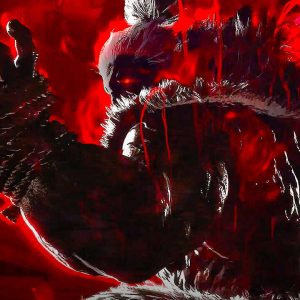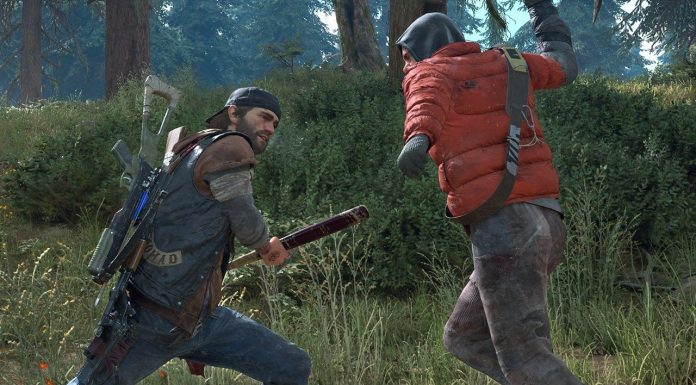As a work of epic fantasy, I expected Final Fantasy XVI to dazzle me visually—especially on my expensive PlayStation 5. But while select scenes do delight visually, they are sadly infrequent. For whatever reason, about halfway through Square Enix’s latest mega-budget RPG the game decides that it’s mostly going to drown you in drab, overcast skies, the amount of which only increase as the story goes on. Thematically appropriate? Perhaps, but instead of inspiring narrative dread, the gloom merely makes for an excessively bland, one-note visual experience that wears on the senses, especially after a couple dozen hours.
Final Fantasy XVI is notable for taking on a darker, more “mature” theme in its storytelling and art design. While the series has never been shy about covering dark themes, FFXVI chooses to go with storytelling and aesthetic styles more befitting of Game of Thrones and similar (usually western) works of fantasy. Too often, sadly, that leaves the game looking wan and dreary. That’s unfortunate, because the map design is otherwise quite lovely.
I’m going to get into some minor spoilers for Final Fantasy XVI as well as the original Final Fantasy VII and Final Fantasy X. You’ve been warned.

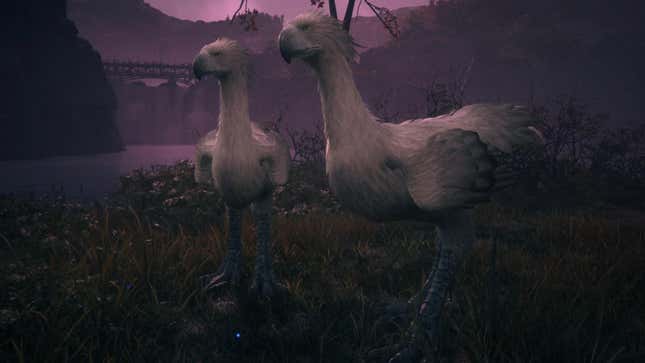
Beach weather this ain’t
Unlike its controversial predecessor, FFXVI made the (smart) decision to forgo an open world in favor of linear-yet-sprawling, interconnected, thematic environments with dedicated setpieces. At first glance, the first few environments, consisting mostly of dark castle corridors and woods, aren’t terribly visually impressive. But the first trip to Martha’s Rest is a breath of fresh air with bright blue skies, lush green vegetation, and distant ruins and mountains. When I first arrived, I felt a sense of openness akin to stepping outside of Final Fantasy VII’s Midgar for the first time. I hoped that was a sign of what was to come, a slow unfurling of visual splendor and lovely colors. But nope!
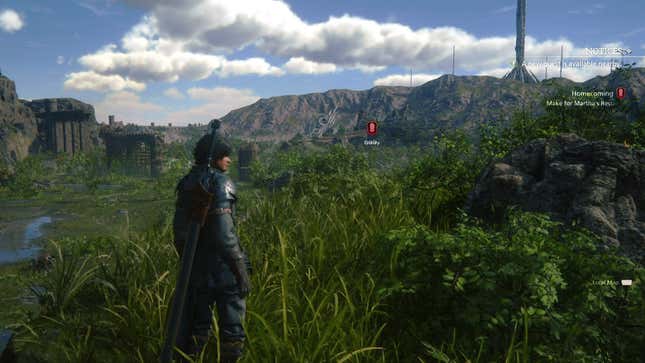
As the story progresses, events in the region of Rosaria take a turn for the worse as villages are attacked by the Black Shields, roaming death squads out to remove “impurities” from the land. This is when the region falls into a never-ending state of overcast with a side of drab. And while sure, thematically it makes sense to go for a moodier, darker palette that reflects the tragedy that befalls the region’s populace, this particular eternal gray treatment makes for a bland, tiring exploration and hunting ground.
It’s not that I’m anti-gloom; Death Stranding pulls off moody vibes with an evocative eeriness that gives that game a memorable ambiance all its own. So I’m not sure if it’s a technical challenge or an artistic one, but whatever’s going on in FFXVI’s dingy landscapes doesn’t work, and I’m not convinced the.constant dreariness is truly necessary to convey the game’s somber themes. And unlike Kojima’s game, unfortunately, FFXVI can’t figure out how to make that aesthetic visually appealing.

The game pulls this “everything sucks now” trick a second time. While its visuals get more lively once you arrive at the desert regions in Dhalmekia, that’s short-lived. At a certain point in the story, the cosmic big-bad Ultima casts the entire world into a state of—you guessed it—cloudy and overcast, and from that point on, the entire world basically sucks to look at.
Dark themes and visual splendor needn’t be mutually exclusive
Final Fantasy’s narratives have never shied away from calamities and other dark themes; very little in FFXVI is arguably any “darker” or “mature” than previous Final Fantasy games. The difference, it seems, is that FFXVI doubles down on the drudgery and misery all the way through to its color palette, and the game is poorer for it. Other Final Fantasy games have embraced wider color palettes, reveling in the benefits of being set in otherworldly fantasy realms while proving that dark themes and rich color palettes aren’t mutually exclusive. Consider Yuna’s “sending” dance, after countless people are murdered by Sin in Final Fantasy X:
FFX’s sending scene not only takes place during a lush sunset, but the blue flame of the torches and the many hues of the spirits of the fallen rising out of the sea creates a visual spectacle that makes for a memorable scene, one that feels like it’s set in a fantasy world. Whereas Final Fantasy XVI feels like it’s set in Seattle or something.
It’s an ongoing problem that spoils side-quests as well. The gloom of eternal overcast skies might’ve been palatable had they been tied to specific narrative beats. But instead, the constant grayness overshadows everything. It’s especially painful given that monster hunts actually task you with scouting out specific locations instead of just beelining to a ping on the map. Yes, in theory I want to spend time traversing Final Fantasy XVI’s world, but when it’s constantly gray and monotone, the whole experience feels miserably the same.
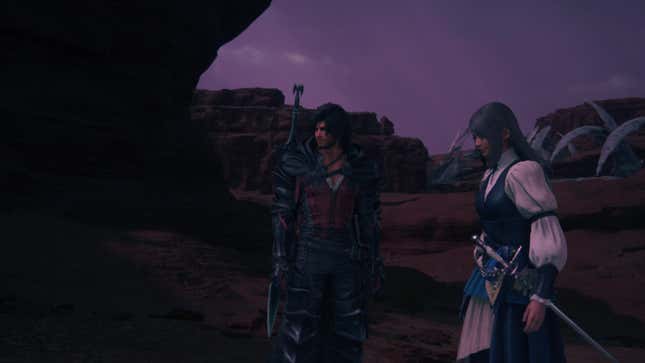
Fear the big scary gray thing in the sky
Final Fantasy XVI disappoints visually yet again in its final act, when the antagonist has sealed himself in a massive crystal that hangs ominously in the sky. But the crystal is mostly just a colorless, featureless object. At first it’s kind of spooky, but that effect barely lasts. In the game’s hub, an NPC often repeats a line about feeling called to it, but that’s never reflected in the visual storytelling, as the crystal just sort of fades into the sky’s bland grayness. Compare that to Final Fantasy VII’s similar late-act backdrop of the bold, purple meteor hanging in the distance. Though hardly visually impressive by modern standards, it’s striking nonetheless.
And nothing going on in FFXVI’s story is any darker than the events of FFVII or FFX, for that matter. FFX is rife with mass death and religious persecution. FFVII sees an NPC throw himself off a cliff because he’s convinced he’ll never be a good father. FFXVI can’t lay claim to exclusively offering “difficult adult themes,” so the sea of endlessly bland, gray skies and otherwise dismal spaces doesn’t really translate to a sense of bold, unique misery unique among Final Fantasy games. At best, the game’s visual appearance is just generic medieval fantasy. And that’s a shame.
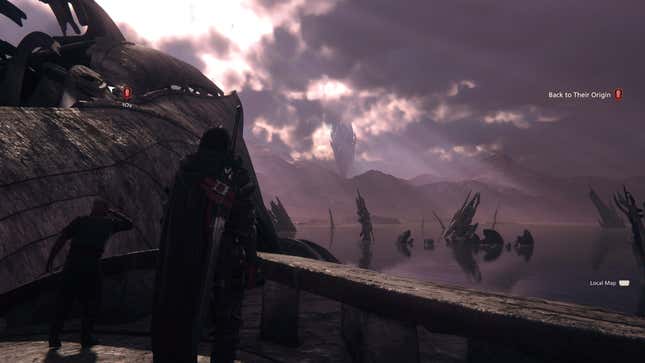
It really doesn’t help that so much else in Final Fantasy XVI is just visually disappointing in other areas. It’s not like there’s much charm or spectacle piercing the dull environments. The ruins left behind by the Fallen (a precursor civilization whose artifacts are strewn about the world) are always the same pale gray color interrupted only briefly by flashes of blue light. The Eikon fights offer a nice reprieve of splashy particle effects, but those also diminish in frequency as the game goes on. And while it is nice to be able to walk around towns again (something FFXV and FFXIII really dropped the ball with), it’s hard to appreciate the map design’s more alluring aspects when it’s all blanketed in that endless mire.
It just wears on you
Some of the game’s environmental problems, I think, could’ve been solved by a simple day and night cycle. Such a dynamic might’ve added a gentle amount of liveness to the linear (though generously wandering) maps. That’d be a start, at least.
But in choosing to freeze the state of the world in place after key narrative moments, and the drudgery bred by the world’s miserable lack of color, I find Final Fantasy XVI depressing to look at in a way that fails to stir affect. It barely even inspires moody dread; instead it’s simply boring. The exhaustively drab and dismal environments have played a significant role in my decision to abandon my quest right before the finale, with little intention of going back to finish it. Even if banishing the big bad from “the Realm” were to suddenly brighten the skies, it’d be too little, too late for this player.


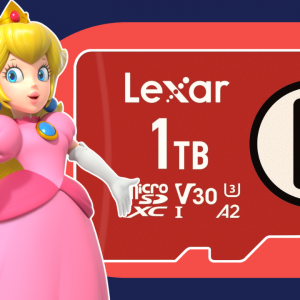



-300x300.jpg)









![DRAGON BALL: Sparking! ZERO – Master and Apprentice Character Gameplay Trailer [BUDOKAI TENKAICHI]](https://gamersroom.info/wp-content/uploads/2024/04/4295814-11-300x300.jpg)

